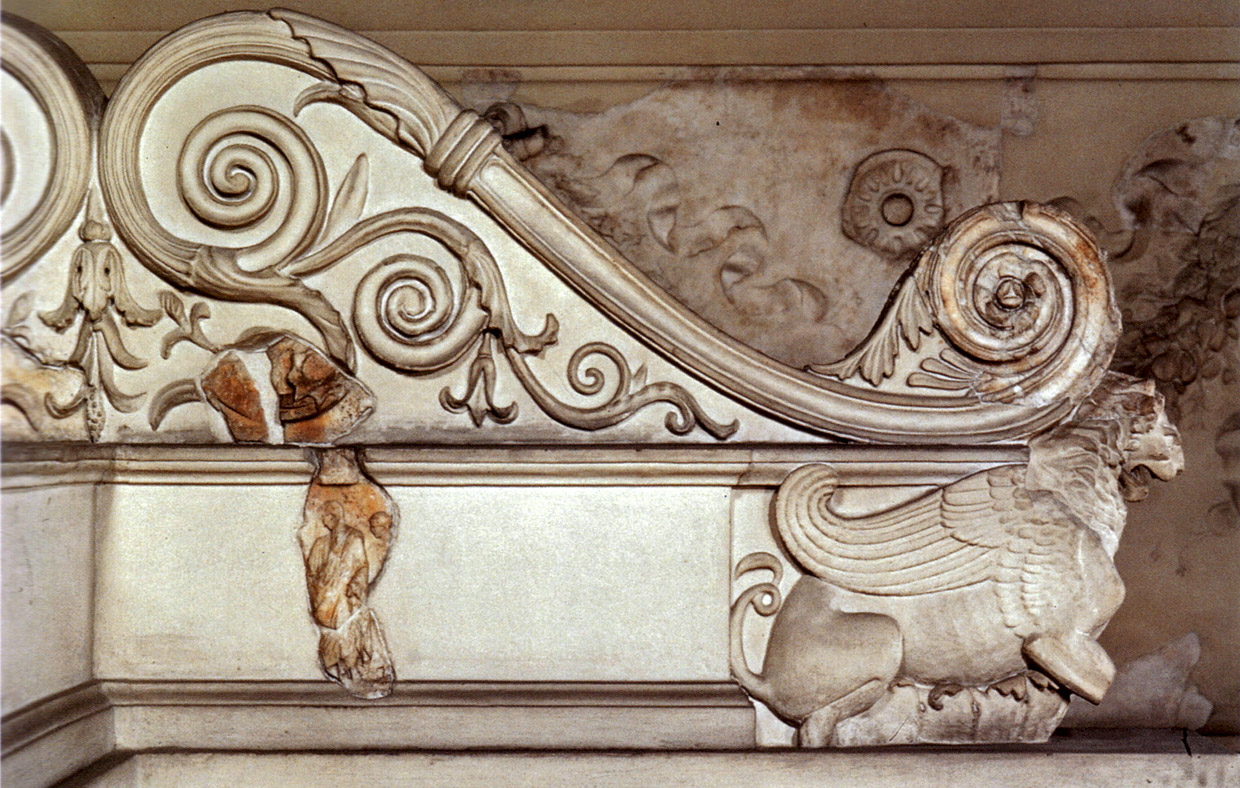
South crowning slab of the sacrificial table, fragment of the frieze with flamen and veiled figure
Rome, Museum of the Altar of Augustan Peace (Ara Pacis Augustae)
South crowning slab of the sacrificial table, fragment of the frieze with flamen and veiled figure.
Rome, Museum of the Altar of Augustan Peace (Ara Pacis Augustae)
(Roma, Museo dell’Ara Pacis).
Description:
Only a fragment from the internal east frieze, facing that of the Vestals, has survived; however this piece is rather important if, in the two figures appearing on it, one recognizes, following Moretti’s interpretation, a flamen and, in the character with a toga and veiled head, Augustus himself, maybe represented in his capacity as Pontifex Maximus, a role he had taken up in 12 BC, after the death of the former pontifex, the triumvir Marcus Aemilius Lepidus. This is a very suggestive hypothesis, and not at all obvious. That of pontifex was certainly the most prestigious role in Roman religious offices: the pontifex was the patron of
the cults and of the state’s religion, responsible for the cult of the Capitoline triad, the person in charge of the official register of the auspice-(the annales maximi), the one who appointed the Vestals and the flamines, in effect the mediator on which Rome relied to keep the pax deorum, the agreement between human actions and gods’ will. In this way his presence on the Ara Pacis appears extremely appropriate and logic. But Augustus accepted this life appointment—that had been of Julius Caesar and that, at Caesar’s death, had been conferred, with an irregular procedure, to Lepidus—only after the death of the former holder, that is when the Ara Pacis was already under costruction. The princeps himself recall this circumstance with emphasis in the Res gestae (10,2) : "I declined to be made Pontifex Maximus in succession to a still living colleague, when the people tendered me the priesthood that my father had held. Several years later I accepted that sacred office when at last the man. who had seized it for himself taking advantage of a time of civil disturbance. was dead..., a multitude never recorded in Rome before gathered from all Italy for my election.
«
If one admits this chronological incoherence. the two small figures on the west crowning slab of the sacrificial table would then allude to a contemporary event of paramount relevance, starting from which the very pontificatus would change its nature, being transformed from an elective office into a honorific title that, starting from Augustus each emperor would have the right to hold.
the cults and of the state’s religion, responsible for the cult of the Capitoline triad, the person in charge of the official register of the auspice-(the annales maximi), the one who appointed the Vestals and the flamines, in effect the mediator on which Rome relied to keep the pax deorum, the agreement between human actions and gods’ will. In this way his presence on the Ara Pacis appears extremely appropriate and logic. But Augustus accepted this life appointment—
«
If one admits this chronological incoherence. the two small figures on the west crowning slab of the sacrificial table would then allude to a contemporary event of paramount relevance, starting from which the very pontificatus would change its nature, being transformed from an elective office into a honorific title that, starting from Augustus each emperor would have the right to hold.
Credits:
© Photo, text: O. Rossini. Ara Pacis. Rome, Electa, 2007, p. 24, 29.
Keywords: γλυπτική sculptura sculpture sculptural scultura skulptur ρωμαϊκό roman romana romano romani römisch römische römisches römischen römischer romain romaine romains romaines ανακούφιση relief rilievo ara pacis augustae altar of augustan peace altare della pace augustea des friedens augustus autel de la paix auguste sacrificial table sacrifice flamen veiled figure volute scroll horizontal corbel console